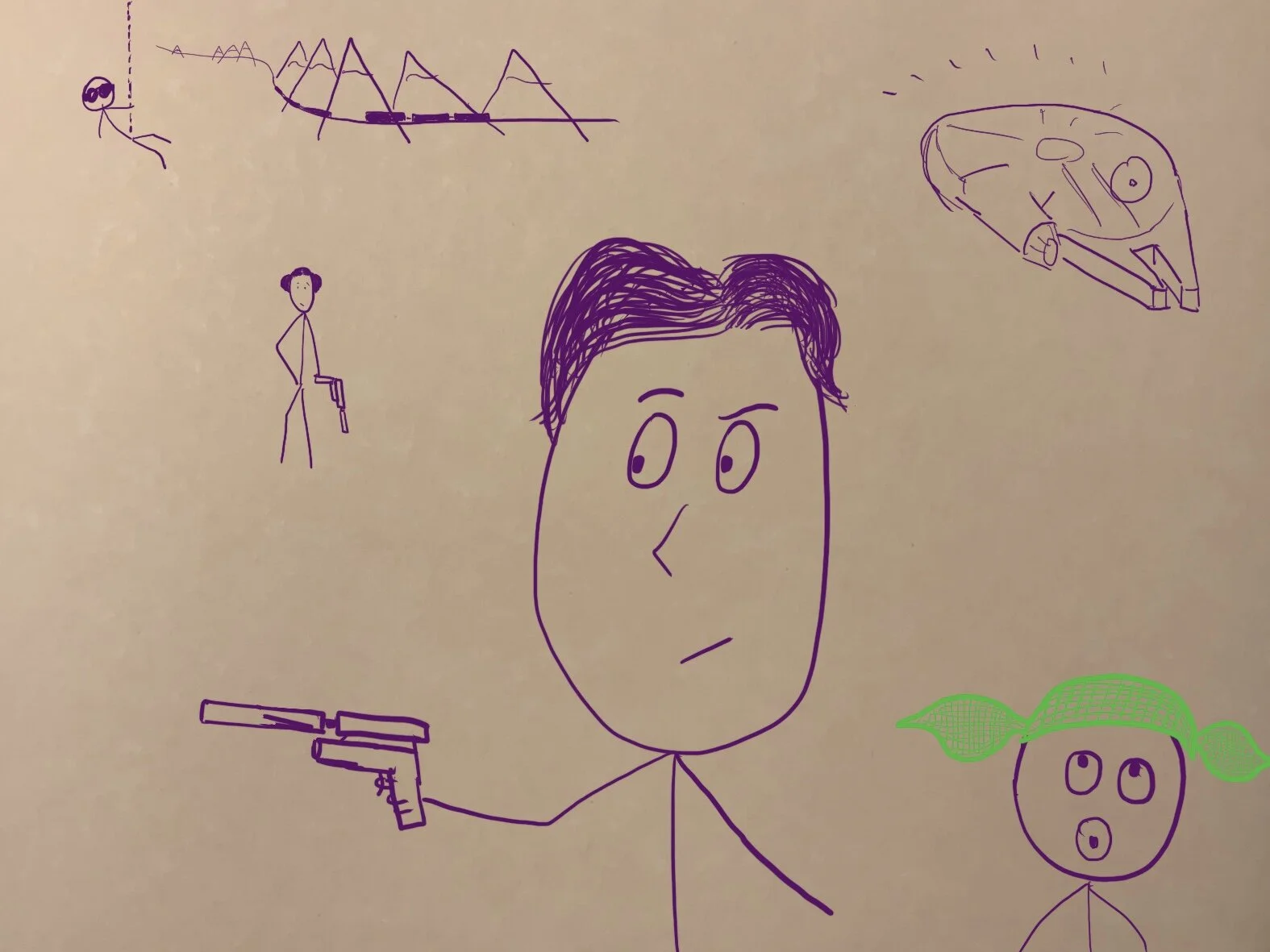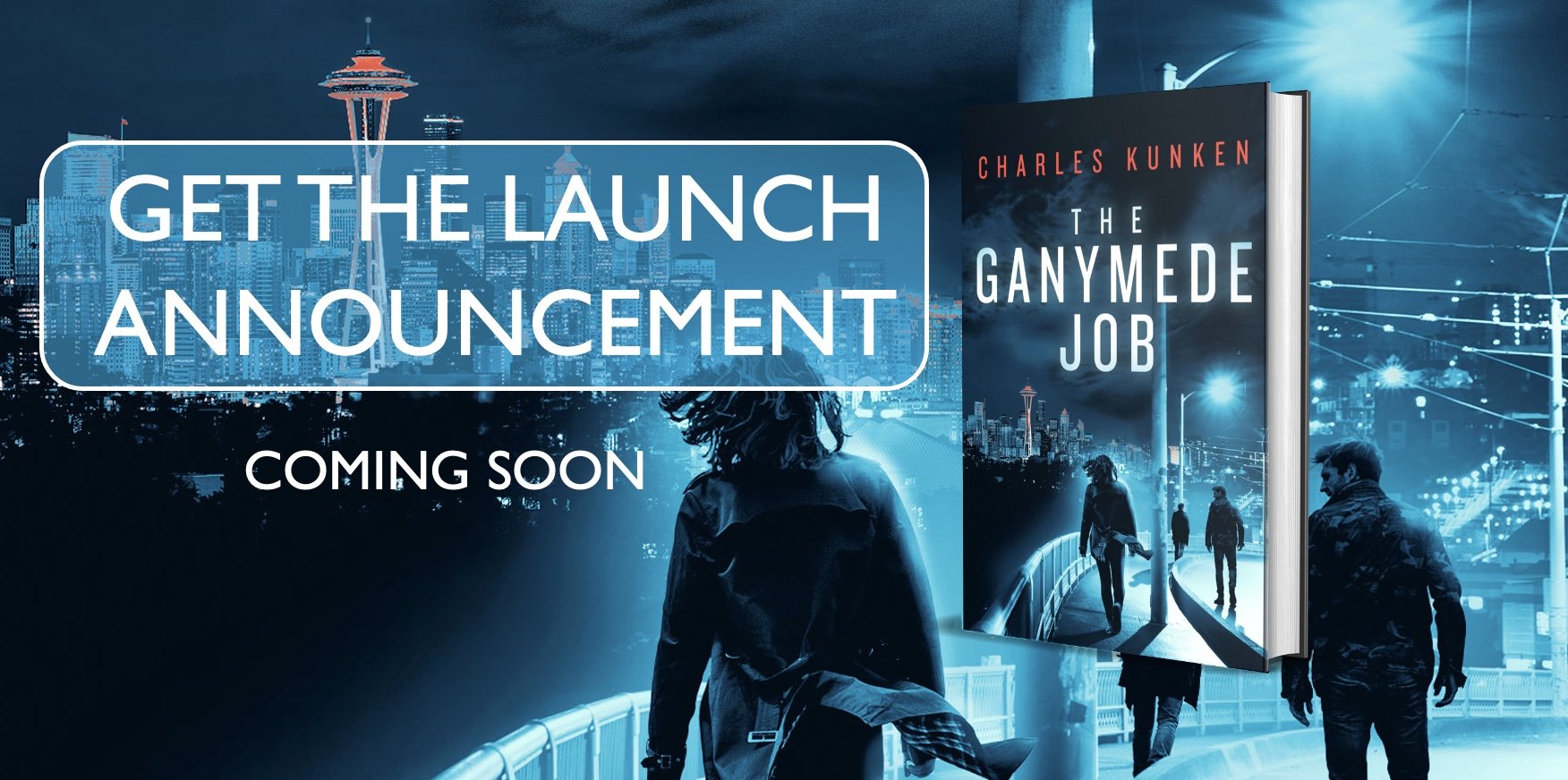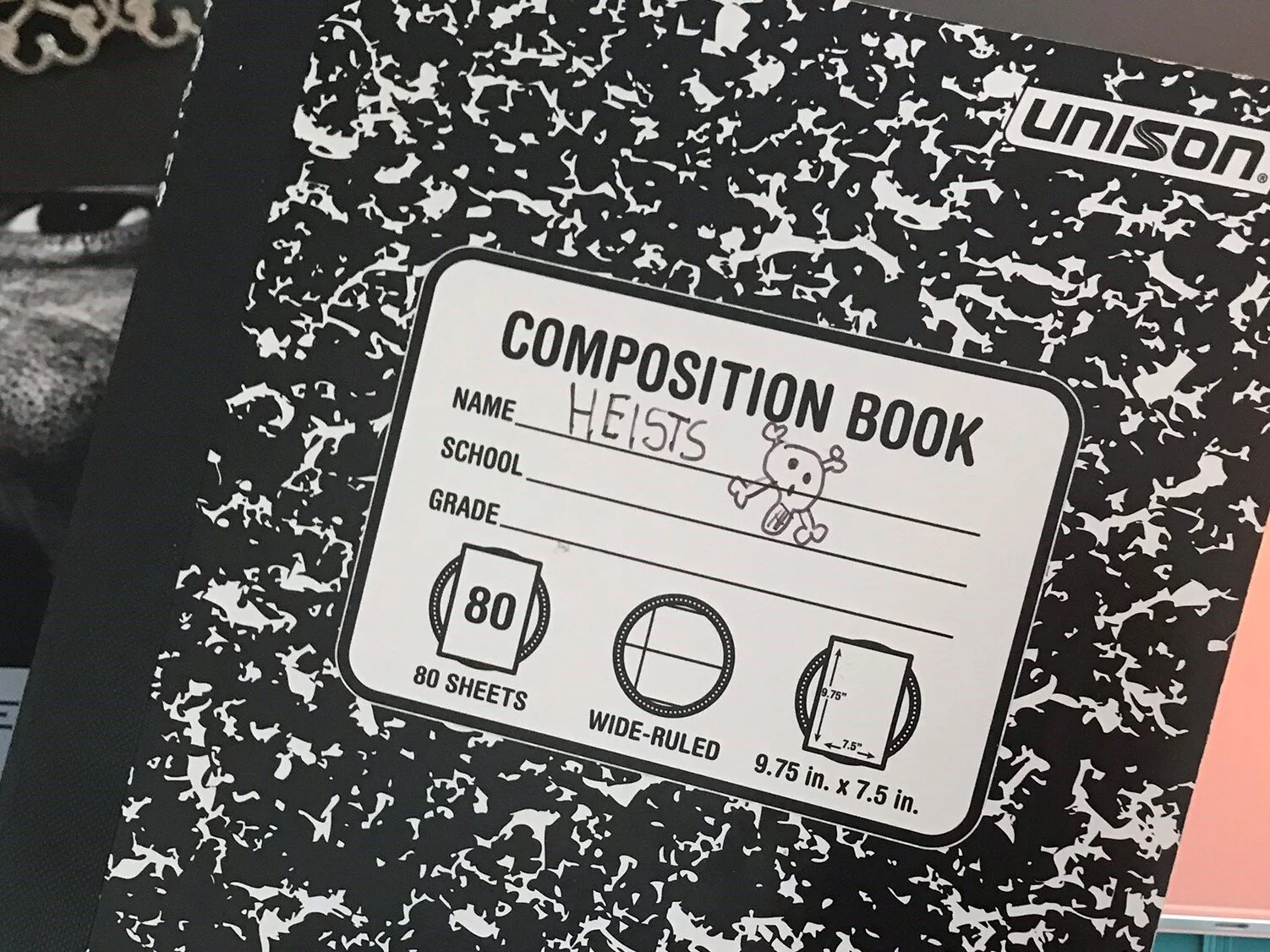Is ‘Solo’ a Heist Film (1 of 3)
Get the full ‘Anatomy Of A Heist’ Series here: charleskunken.com/season4
The Skytalkers podcast recently aired an episode in which they ran Solo: A Star Wars Story (2018) through the heist tracker - the one we made together during paternity leave ;) charleskunken.com/blog/the-anatomy-of-a-heist-the-16-conventions-part-1-of-3).
Hosts Caitlin and Charlotte used the 16 conventions to try and answer the question, ‘Is Solo a heist film?’ It was a great show (I’m biased of course) and if you love Star Wars + heists then I highly recommend to give the ep. a listen! (And subscribe!)
Wait a tick, Star Wars plus heists, you say? This is the coolest movie premise ever! Yes! Hence, the reason we are going to take this inspiration from our friends at Skytalkers and contribute our own in-depth analysis of Solo. All 16 conventions in a 3-part series starting with part 1 right here, right now. Without further ado, here’s the ‘Milk in The Matrix version of ‘is Solo a heist film?’
-
The Promise of Stories
Stories make an implicit promise to their audience of what they should expect to see. That promise is what we call genre.
Genres are defined by typical scenes known as ‘conventions’. They are moments the audience will subconsciously be anticipating.
Shawn Coyne, who you’ve heard me discuss ad nausea by now, and his Storygrid methodology makes a point of drilling into writers that they better know their conventions. For example, in a love story you have to include the lovers’ first kiss, in a crime story you need to provide a gumshoe, and in a thriller you better show the hero at the mercy of the villain.
If you don’t respect the conventions, you’ll be breaking the promise to the audience and they will leave disappointed, that is if they even stay for the whole thing.
Image: Lucasfilm Ltd., Walt Disney Studios Motion Pictures
Know Your Roots
At the same time, audiences don’t want to see the same old recycled solutions.
If you wrote a movie strictly to the existing conventions you’d be merely copying the last flick in the genre instead of pushing the envelope further.
You need to know the rules - how the classics delivered the goods - so that you can break them. Your conventions tell you where to start.
The ‘Anatomy Of A Heist’
The ‘Anatomy Of A Heist’ project had one purpose and one purpose only - to develop guidance for myself, as a writer. I’m writing a heist novel.
It was not a mechanism to rank movies, it was a tool to find out what exactly made the best ones so enjoyable.
I just finished the second draft (charleskunken.com/hollywoodheist). This might sound far along but I assure you it’s not. its ready to be a book like a misshapen ball of clay is ready to be a sculpture.
The heist tracker was to try and figure out how to deliver on the promise. And then some.
So, Was Solo A Heist Film?
The promise of Solo, first and foremost is it’s obligation as a Star Wars flick. As a serious casual fan myself that means to me sci-fi, space opera, and action.
It’s also an origin story, which means it had to incorporate as many of the references from past Star Wars films as possible and show us their background here. Those are the plot points we came to see.
I did a little Wikipedia research to get my bearings and found that Solo was co-written by Lawrence Kasdan, the original co-writer on The Empire Strikes Back (1980) and Return Of The Jedi (1983). His son, Jonathan Kasdan was the other co- on Solo so there is little doubt they knew what they had to do.
Movies, especially Star Wars do blend genres however, and Solo definitely layers on elements of the heist, but it rightly prioritized the necessity to deliver on the Star Wars promise first.
So, ‘was Solo a Heist Film? I’d say no, or at least that it was not a pure-breed. Nor should it have been. But we’ll examine just how successfully it incorporated heist elements into its framework, where it rightly deviated from the conventions, and where it could have done better.
The Heist Tracker
With all that said, let’s dissect the conventions one by one, after all that’s what we came to see. Isn’t it? ;)
-
1. A Story About A Single Score
The convention as originally described in the blog:
A proper heist film is a story about the preparation and execution of a single big score. They are stories all about how our heroes steal something, not why (a fact that most bad heist movies miss).
This means the target of the heist needs to be established right out of the gate.
Did Solo meet the convention? No
The story opens with an extended display of Solo in his quote-unquote “normal world” (I like to say ‘quote-unquote’). The story doesn’t open with the inciting incident that directly puts the job in motion.
This however was a good departure from the convention. We needed that time with Han first. As an audience we’re not itching to get into the job. We’re itching to see young Solo and get a glimpse into his back story. The Kasdan screenplay scratches that itch.
Solo does not adhere to the convention of a pure breed but this departure best serves the movie.
*Sidenote 1 - Just because the climax of the movie revolves around the heist does not mean it meets the criteria of this convention either. In a pure breed the story is about the heist from beginning to end. Remember in Dead Presidents (1995), the first mention of the armored truck is not until 73 minutes (64%) into the film. It ends with a score but the movie is all over the map up until that point.
*Sidenote 2 - Solo has the element of two scores, not one. This was a departure from the convention that we’ve seen before in The Italian Job (remake, 2003) and Ocean’s 12 (2004).
The first mention of the first score in Solo comes at 14% when Solo overhears Beckett talking and tries to get into his gang. The first mention of the second score comes at 38% when the crew is trying to think of ways to make up the failed first attempt to Dryden Vos.
These plot points occur in The Italian Job at 3% and 27% while in Ocean’s 12 they occur at 6% and 51%, for whatever that’s worth.
It is not automatically bad when movies deviate from the conventions. Conventions should serve the story. Not vice versa. If it improves the movie its good. I personally enjoyed Ocean’s 12 more than The Italian Job remake and I think the two scores worked even better in Solo.
2. The Perpetrator Is The Hero
Original description of the convention:
Crime stories are about cops, heists are about thieves. The protagonist must be the one pulling off the job.
Take Point Break (1991) for instance. While the string of robberies seems ‘heisty’ our hero is Keanu Reeves, FBI.
This is a yes for Solo.
It’s ok that Han is not leading the heists, per se. Our hero is on the heist team and let’s not forget he sort of becomes the de facto lead by the end.
*Sidenote – did Han really start the rebellion? I’m not sure if I’m putting all the pieces together correctly, but if so, that is way cool.
3. The Hero Already Wants To Steal Things
Original description of the convention:
Trying to quickly jam in the whole backstory of why our hero goes from civilian to thief at the beginning of the film doesn’t work. It often comes out cheesy and leads to a caper (meaning, the job is run by a group of amateurs).
The character arc demonstrating the fall towards a life of crime is a separate story altogether. It requires a movie full of its own conventions and obligatory scenes in order to be sympathetic.
This is a yes for Solo.
In Solo, it is not a moral deviation for Han to want to join up with Beckett’s crew in the heist. Participating in the job is completely in-line with who he is at the beginning of the film.
4. The Heist Must Be A Success
Original description of the convention:
We want victory for our heroes. Justice is for villains.
When the arc of a story has created characters that we have grown to love and made them our heroes then it is a cathartic let down to see them fail.
Heist #2 in Solo, the climactic one, was a success. There were some losses along the way that aligned more with classical drama than the fun and games of an Ocean’s flick, but they were in line with this story.
We’ll call this convention a ‘yes’ for Solo.
5. The Hero Gets The Want AND The Need
This is definitely a fun one. Let’s look at the original language of the convention:
In the classic rules of drama in the end of a story the hero must sacrifice ‘The Thing They Want’ in order to gain ‘The Thing They Need’.
For example in Titanic (1997) Rose loses Leo to the icy Atlantic but is then emboldened to finally escape the shackles of society imposed by her mother and fiancé by hiding from them on the rescue ship. I’m tearing up just thinking about it.
But in a heist the sacrifice is a fake…master thieves get the money AND the girl.
Let’s start by breaking this down. So what is Solo’s want and need?
At the start of the movie the ‘want’ (the thing that he thinks will make his life whole again) is to achieve freedom with Qi’ra, his woman.
As the story progresses and Han works towards his goal he collects experiences. He explores the world away from his home, he trains in the army, he gets involved in some adventures, he joins a crew, and he meets Chewie.
As Han grows and overcomes hurdle after hurdle we come to see that the thing he needs is this life of adventure. And a buddy.
In the end he does sacrifice the want. He leaves Qi’ra’s side to go rescue Chewie from Beckett. We then see that Qi’ra has some complicated alliances going on and she ends up ditching Han in the end. (Even though it seems like she still has affection for him, right?)
So Han doesn’t get the want. In fact he makes the classic sacrifice to get the need.
But take this example of the convention from our the same original blog post which highlights how this one is supposed to make you feel:
In the last scene of The Thomas Crown Affair (the 1999 one) after Pierce Brosnan has gotten away with the crime, Rene Russo – his investigator and love interest - is flying home. Crown is free but solo and Rene appears heart broken – she sacrificed their love affair in lieu of doing her job.
But just before the movie ends Crown jumps out from behind the next seat! He’s on the plane! They start making out as the screen fades to black and we can only surmise that they will spend the rest of their days making sweet love somewhere on an exotic beach. Now that’s how you end a heist.
Master thieves get the money AND the girl.
So in the last scene of Solo Han wins the Millennium Falcon from Lando Calrissian in the infamous card game that I think was first referenced back in 1977 in Star Wars: A New Hope.
This ending is not only extremely ‘heisty’, in that it ends on a big win, it is also one of the most important scenes in the movie. If the audience came to see two things it was to watch Han and Chewie meet and to see Han win the Falcon.
Han might not have technically ‘gotten the girl’ but the movie ended on a scene that made me jump up and cheer. Solo absolutely captured the spirit of this convention.
This payoff was 41 years in the making. Bet your @$$ I’m giving it a yes.
-
Tune in next week as we keep this going with conventions 6-10!!
-
Questions, comments, complaints…drop me a line! charlie@charleskunken.com
Other Posts In The Anatomy Of A Heist Series
Storytelling Resources
The LIST
The 41 films conducted during the research project (full explanation here)














The Skytalkers podcast recently aired an episode in which they ran Solo: A Star Wars Story (2018) through the heist tracker - the one we made together during paternity leave ;) charleskunken.com/blog/the-anatomy-of-a-heist-the-16-conventions-part-1-of-3).
Star Wars plus heists? Yea…we just had to take this inspiration from our friends at Skytalkers and contribute our own ‘Milk in The Matrix version of ‘is Solo a heist film?’